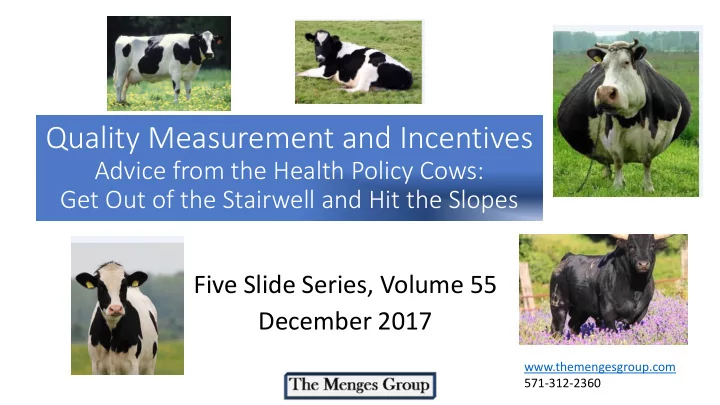

Quality Measurement and Incentives Advice from the Health Policy Cows: Get Out of the Stairwell and Hit the Slopes Five Slide Series, Volume 55 December 2017 www.themengesgroup.com 571-312-2360
Overview • This edition focuses on how quality can best be reported and rewarded in the coordinated care arena • Our key messages/suggestions: • Fully utilize performance data to differentiate health plans, providers, etc. The Five Star quality reporting system used extensively in Medicaid and Medicare is terrific, but the rounding of the ratings that occurs is blunt and “Maybe some animals are more masks a great deal of valuable information. equal than others. Maybe not. But • Financial incentives around specific statistical one care gap is one care gap.” -- Franny targets reward achievement at just a few arbitrary points along a wide continuum of performance. 2
CMS and NCQA Arduously Collect and Tabulate Detailed Health Plan Quality Data – Only to Then Mask Much of the Differentiating Information in their Published Ratings (by grouping MCOs to the nearest “half star”) NCQA Medicaid Health Plan Ratings, 2017-2018 • The most recent distribution of NCQA’s Medicaid health plan ratings is shown in the table, with a column added showing the wide range of detailed scores that are Number of grouped into each published cohort. Published Actual Performance Medicaid • Rating Range MCOs The same issues exist with CMS and NCQA quality ratings of Medicare Advantage health plans. 5.0 4.75 or greater 1 • 4.5 4.25 - 4.74 10 In published reports, a health plan’s more detailed score should be shown – in lieu of or in addition to the broad “Star Group” each plan falls into. 4.0 3.75 - 4.24 29 3.5 3.25 - 3.74 69 • Given the degree to which health plans are bunched in the 3.0 to 4.0 cohorts (84% of the Medicaid plans have a rating in this range), it is particularly important for 3.0 2.75 - 3.24 51 beneficiaries and other stakeholders to be able to ascertain more detailed scores. 2.5 2.25 - 2.74 11 2.0 1.75 - 2.24 4 1.5 1.25 - 1.74 3 “By publishing a 4.5 rating for someone at 4.27 and a 4.0 rating for someone at 4.23, we are exaggerating -- and hiding -- the actual difference between these two MCOs. And then by assigning a 4.0 to all plans between 3.75 and 4.24, we are keeping a lot of valid differentiating information out of play, implying these health plans are all equal performers when they aren’t. It needs to be said that the cow community would never report this information in this way.” -- Giselle 3
Rounded Star Scores Encourage “Stair - Step” Financial Incentives • Bonus payments tied to a health plan’s rounded rating on the 5 point scale exacerbate the concerns described on the previous slide. • Actual performance differences get distorted by grouping health plans to the nearest half-star and “Here’s the bonus I get from you when my performance improves continuously and steadily: corresponding financial Nuthin, nuthin, nuthin, nuthin, nuthin, nuthin, rewards/penalties become nuthin, then finally a fair payment. And that tape imprecise and can often be unfair. plays again up to the next threshold .” -- Gilligan 4
“Slope versus Stair- Step” Issues Also Exist with Providers’ Incentive Compensation • “Paying for value” and “paying for performance” are increasingly being incorporated in health plans’ provider compensation. • Awarding large payment enhancements only when certain thresholds are reached (the stair- step or target approach) can create an array of unfair payment outcomes between providers. • A “slope approach,” whereby providers’ incentive compensation is precisely tied to wherever they are on the performance continuum, is usually more appropriate. “There needs to be some reasonable performance threshold below which no • Incentive payments in this structure can accurately bonus is warranted. But I don’t get all this reflect a provider’s absolute performance level, as fascination with arbitrary targets. Marginal well as the degree of improvement that occurred versus a prior timeframe. improvement from wherever you were before is always valuable.” -- Millicent 5
Our Contact Information Phone: 571-312-2360 Website: www.themengesgroup.com Email: jmenges@themengesgroup.com Address: 4001 9 th Street N., Suite 227 Arlington, VA 22203 Our 5 Slide Series conveys data and/or opinions with the intention of helping inform and improve health policy decision-making involving the Medicaid and Medicare programs. Our company’s focus is on the design and operation of coordinated care programs that strive to “I don’t always get a make optimal use of taxpayer funds to favorably impact the health bonus. But when I do, I status of public health program beneficiaries. use a purple font to tell people about it ” To be added to our list to receive these as they are published (or to be -- Armando removed), please email us. (still widely recognized as the most interesting cow in the In producing this particular edition, no actual cows were mistreated, world) disparaged, or over-rewarded. 6
Recommend
More recommend